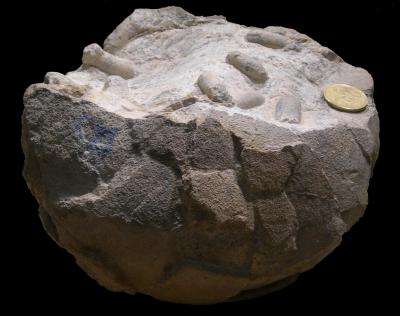Fossil forensics reveals how wasps populated rotting dinosaur eggs

Exceptionally preserved fossils of insect cocoons have allowed researchers in Argentina to describe how wasps played an important role in food webs devoted to consuming rotting dinosaur eggs. The research is published in the scientific journal Palaeontology.
The approximately 70 million year old eggs, from gigantic titanosaur sauropod dinosaurs were discovered in 1989 in the Patagonia region of Argentina, well known for yielding fossils of sauropod dinosaur eggs and even embryonic dinosaurs. Only recently it was discovered that one of the broken eggs contained tiny sausage-shaped structures, 2-3cm long and 1cm wide. The structures closely resembled fossilised insect cocoons, and were most similar in size and shape to the cocoons of some species of modern wasp.
There are many records of fossilised dinosaur eggs, and even several records of fossil cocoons, but, as author Dr Jorge Genise of the Museo Argentino de Ciencias Naturales states "this is the first time that these cocoons are found closely associated with an egg". Such a study of organismal behaviour (e.g. burrows, footprints) is known as ichnology.
The results indicate "that wasps probably participated in the food web, mostly composed of scavenging insects, which developed on the rotten egg". The make-up of carrion communities – spiders, beetles and other creatures populating rotting organic matter – is more familiar to us from the screens of crime scene investigation documentaries.
The numbers and different types of creatures indicate the length of deposition and the time since death. In this particular CSI, it appears that the dinosaur egg was broken by force, and subsequent fractures in the egg shell allowed scavenging creatures to feed upon the contents. At egg sizes of around 20cm, this represents a sizable amount of yolk! Other creatures later appeared to feed not upon the egg contents, but on the initial scavengers themselves. The wasps represent the top of the food web, and could have been feeding on insects or spiders gorging on rotting egg contents.
These scavengers also played an important role in cleaning up nest sites. Palaeontologists believe that some dinosaurs revisited nest sites year after year to lay new clutches of eggs. Carrion communities were essential to removing decaying material in advance of new nesting seasons. This new discovery gives us an insight into the murky world of insect communities that thrived at the feet of gigantic dinosaurs.
Provided by Wiley

















